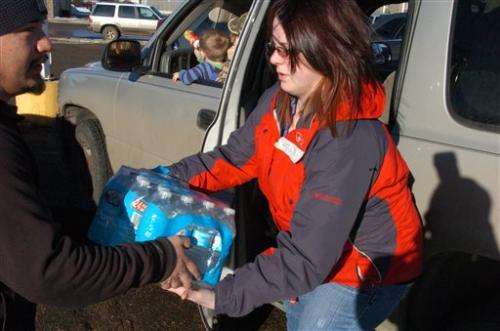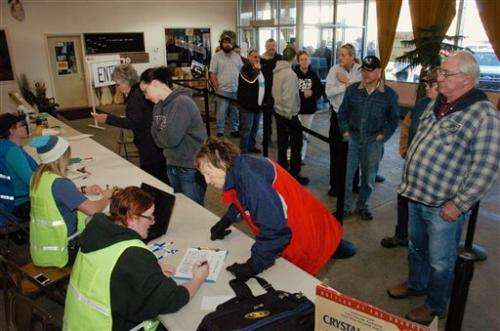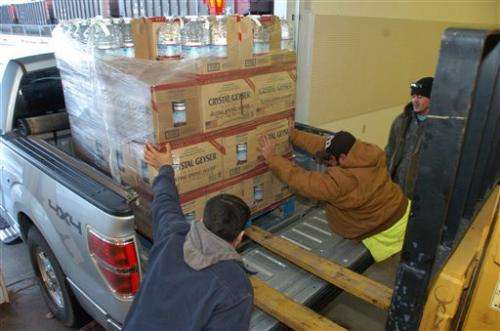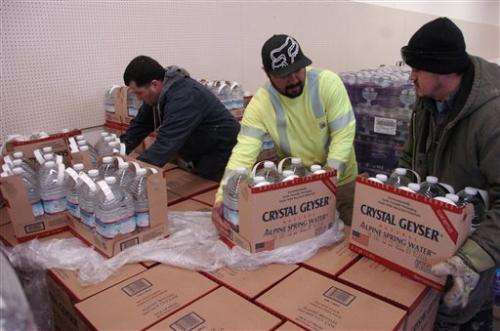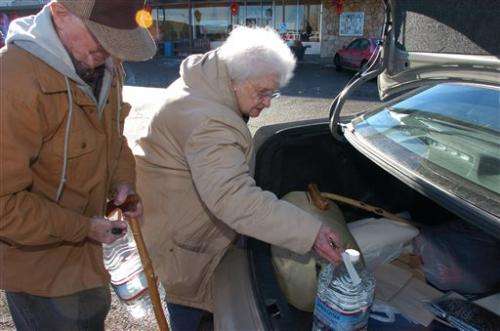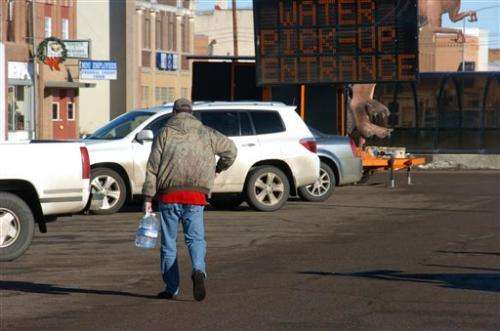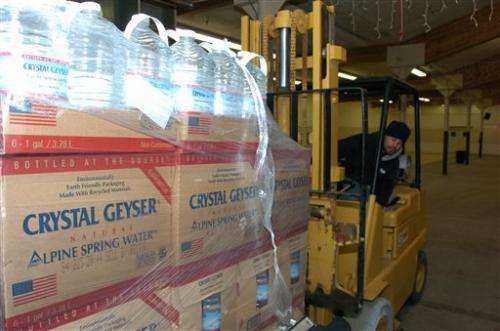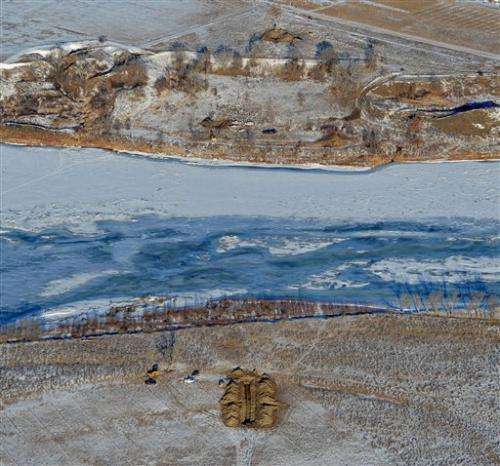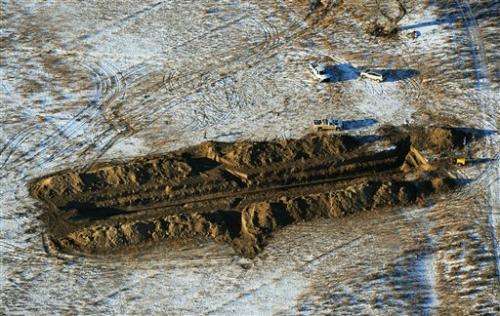Cesar Rodriguez, left, hands a case of bottled drinking water to Whitney Schipman of Glendive, Mont., on Tuesday, Jan. 20, 2015. Officials said benzene levels were too low to pose a short-term health risk but they warned the city's residents against drinking tap water out of precaution. Elevated levels of benzene were found in water samples taken from a treatment plant that serves about 6,000 people in the agricultural community of Glendive near the North Dakota border. The contamination followed a 50,000 gallon oil spill that found its way from a break in a Bridger Pipeline's 12-inch pipeline into the Yellowstone River. (AP Photo/Matthew Brown)
Eastern Montana residents rushed to stock up on bottled water Tuesday after a cancer-causing component of oil was detected in public water supplies downstream of a pipeline spill on the Yellowstone River.
Elevated levels of benzene were found in water samples taken from a treatment plant that serves about 6,000 people in the agricultural community of Glendive, near North Dakota.
Scientists from the federal Centers for Disease Control and Prevention said the benzene levels were above those recommended for long-term consumption, but did not pose a short-term health hazard. Residents were warned not to drink or cook with water from their taps.
Some criticized the timing of Monday's advisory, which came more than two days after 50,000 gallons of oil spilled from the 12-inch Poplar pipeline owned by Wyoming-based Bridger Pipeline Co. The spill occurred about 5 miles upstream from the city.
Adding to the frustrations was uncertainty over how long the water warning would last. Also, company and government officials have struggled to come up with an effective way to recover the crude, most of which appears to be trapped beneath the ice-covered Yellowstone River.
By Tuesday, oil sheens were reported as far away as Williston, North Dakota, below the Yellowstone's confluence with the Missouri River, officials said.
"It's scary," said 79-year-old Mickey Martini of Glendive. "I don't know how they're going to take care of this."
Martini said she first noticed a smell similar to diesel fuel coming from her tap water Monday night. By morning, the bottled water she got from a neighbor had run out. Martini said she was unable to take her daily medicines for a thyroid condition and high cholesterol until she picked up water from a public distribution center later in the day.
Representatives from the state and the U.S. Environmental Protection Agency earlier said preliminary monitoring of the city's water showed no cause for concern. The water treatment plant operated until Sunday afternoon, more than 24 hours after pipeline operator Bridger Pipeline discovered the spill, officials said.
Residents line up to receive drinking water from a distribution center, Tuesday, January 20, 2015, in Glendive, Mont. A cancer-causing component of oil has been detected in the Glendive drinking water supply, just downstream from a crude oil spill that entered the Yellowstone River. (AP Photo/Matthew Brown)
Additional tests were conducted early Monday after residents began complaining of the petroleum- or diesel-like smell from their tap water. That's when the high benzene levels were found.
Benzene in the range of 10 to 15 parts per billion was detected from the city's water, said Paul Peronard with the EPA. Anything above 5 parts per billion is considered a long-term risk, he said.
Peronard acknowledged problems in how officials addressed the city's water supply, including not having the right testing equipment on hand right away to pick up contamination. But Peronard and others involved in the spill response said officials acted based on the best information available.
"Emergencies don't work in a streamlined fashion," said Bob Habeck with the Montana Department of Environmental Quality. "It's a process of discovery and response."
Several residents interviewed by The Associated Press said they first heard about the water problems through friends and social media sites, not the official advisory.
"They could have been more on top of it," Whitney Schipman said as she picked up several cases of bottled water for her extended family from a water distribution center. "As soon as there was a spill, they should have told everybody."
Officials took initial steps Tuesday to decontaminate the water system. Glendive Mayor Jerry Jimison said it was unknown when the water treatment plant would be back in operation.
Until that happens, Bridger Pipeline spokesman Bill Salvin said the company will provide 10,000 gallons of drinking water a day to Glendive.
Adrian Vargas, left, and Santiago Medina push a pallet loaded with drinking water into the back of a pickup truck, Tuesday, Jan. 20, 2015, in Glendive, Mont. A cancer-causing component of oil has been detected in the Glendive drinking water supply, just downstream from a crude oil spill that entered the Yellowstone River. (AP Photo/Matthew Brown)
The company established a hotline for people with questions about the water supply and to report any wildlife injured by the spill: (888) 959-8351.
Another pipeline spill along the Yellowstone River in Montana released 63,000 gallons of oil in July 2011. An Exxon Mobil Corp. pipeline broke during flooding, and oil washed up along an 85-mile stretch of riverbank.
Exxon Mobil faces state and federal fines of up to $3.4 million from the spill. The company has said it spent $135 million on the cleanup and other work.
The Poplar pipeline involved in Saturday's spill runs from Canada to Baker, Montana, picking up crude along the way from Montana and North Dakota's Bakken oil-producing region.
Adrian Vargas, left, Santiago Medina and Rodrigo Salas prepare cases of water for distribution to residents in Glendive, Mont., Tuesday, Jan. 20, 2015. A cancer-causing component of oil has been detected in the Glendive drinking water supply, just downstream from a crude oil spill that entered the Yellowstone River. (AP Photo/Matthew Brown)
The pipeline receives oil at four points in Montana: Poplar Station in Roosevelt County, Fisher and Richey stations in Richland County, and at Glendive in Dawson County. The section of pipeline that crosses the Yellowstone River was last inspected in 2012, in response to the Exxon accident, according to company officials.
Salvin said the line was at least 8 feet below the Yellowstone River bed where it crosses the river near Glendive.
No cost estimate for the Glendive spill was yet available.
-
Bob Sarver and his wife, Melvina, load water into their car trunk, Tuesday, Jan. 20, 2015, in Glendive, Mont. A cancer-causing component of oil has been detected in the Glendive drinking water supply, just downstream from a crude oil spill that entered the Yellowstone River. (AP Photo/Matthew Brown)
-
Eric Held carries water to his vehicle at a public distribution center, Tuesday, Jan. 20, 2015, in Glendive, Mont. A cancer-causing component of oil has been detected in the Glendive drinking water supply, just downstream from a crude oil spill that entered the Yellowstone River. (AP Photo/Matthew Brown)
-
Javier Garcia, with Bridger Pipeline, transports a pallet of drinking water, Tuesday, Jan. 20, 2015, in Glendive, Mont. A cancer-causing component of oil has been detected in the Glendive drinking water supply, just downstream from a crude oil spill that entered the Yellowstone River. (AP Photo/Matthew Brown)
-
Crews work to contain an oil spill from Bridger Pipeline's broken pipeline near Glendive, Mont., in this aerial view showing both sides of the river on Monday, Jan. 19, 2015. Officials said that they were bringing truckloads of drinking water to Glendive after traces of 50,000 gallons of oil that spilled into the Yellowstone River were found in the city's water supply. (AP Photo/The Billings Gazette, Larry Mayer)
-
Crews work to contain an oil spill from Bridger Pipeline's broken pipeline near Glendive, Mont. in this aerial view on Monday, Jan. 19, 2015. Officials said that they were bringing truckloads of drinking water to Glendive after traces of 50,000 gallons of oil that spilled into the Yellowstone River were found in the city's water supply. (AP Photo/The Billings Gazette, Larry Mayer)
© 2015 The Associated Press. All rights reserved.
